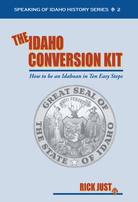When you think of dancing today, images of people having fun probably pop into your head. Yet, dancing has been prohibited in many places throughout history. Some adherents to religions, from Islam to Baptists, forbid dancing.
Dance is a vital part of other religions. That brings us to a moment in Idaho history where a particular dance was outlawed.
A headline in the Blackfoot Optimist in 1912 read, “Last Indian Sun Dance.” The tribes of the Fort Hall reservation were about to hold what would “be the last dance ever held on the reservation.”
The Indian Department in Washington, DC had issued an edict that the tribal custom of holding a sun dance would be prohibited in future years. Why? “It is claimed by those in authority that those dances interfere with and retard the process of teaching the Indians the necessity of following the white man’s example of engaging in agricultural pursuits, rather than those of their more savage ancestry,” the article explained.
Sun dances seem to have originated with the plains Indians. However, by the late 1900s, they had spread to the Shoshone of Wyoming and Idaho. The days-long ceremonies varied by tribe and varied from year to year depending on the vision a medicine man had received.
You may think of sun dances as the ritual where a warrior’s pectoral muscles are pierced and rawhide thongs run through the piercings. In that version, a rope is tied to a center pole and the embedded thongs while the warrior leans back to endure the pain. While some sun dances feature that display of personal sacrifice, they more commonly involve tribal members dancing from the center pole and back to the edge for hours on end, often fainting from exhaustion.
In the Shoshone Sun Dance, tribal members erected a circular enclosure of poles and brush, about 60-75 feet in diameter. The center pole was cut from a birch tree ceremonially chosen for that purpose.
A 1918 story in the Idaho Republican described the dance this way: “Around the edge of the dancing space were a number of peeled poles to which the dancers could hold or rest against when not in action. Each dancer had his own particular station, and the method of dancing was to dance straight up to the center pole and then backwards to the station to the outer ring.” The dance described in that article lasted “from sunset Tuesday to sunrise Saturday.”
That 1918 story, as clever readers will note, came after the “last dance” story in the Blackfoot paper in 1912. That’s because tribal members had held the dance despite the prohibition. They did so regularly and continue the tradition today. In 1978, Congress passed the American Indian Religious Freedom Act, which codified the right of Native Americans to freely practice their religious rights, including the Sun Dance.
In that same 1912 paper that mentioned their “savage ancestry,” the writer was troubled by the discontinuation of the ritual. “In compelling them to discontinue one of the most sacred forms of religion, there is a question as to whether any man has a right to forcibly interfere with anyone’s religious belief.”
Indeed.
Dance is a vital part of other religions. That brings us to a moment in Idaho history where a particular dance was outlawed.
A headline in the Blackfoot Optimist in 1912 read, “Last Indian Sun Dance.” The tribes of the Fort Hall reservation were about to hold what would “be the last dance ever held on the reservation.”
The Indian Department in Washington, DC had issued an edict that the tribal custom of holding a sun dance would be prohibited in future years. Why? “It is claimed by those in authority that those dances interfere with and retard the process of teaching the Indians the necessity of following the white man’s example of engaging in agricultural pursuits, rather than those of their more savage ancestry,” the article explained.
Sun dances seem to have originated with the plains Indians. However, by the late 1900s, they had spread to the Shoshone of Wyoming and Idaho. The days-long ceremonies varied by tribe and varied from year to year depending on the vision a medicine man had received.
You may think of sun dances as the ritual where a warrior’s pectoral muscles are pierced and rawhide thongs run through the piercings. In that version, a rope is tied to a center pole and the embedded thongs while the warrior leans back to endure the pain. While some sun dances feature that display of personal sacrifice, they more commonly involve tribal members dancing from the center pole and back to the edge for hours on end, often fainting from exhaustion.
In the Shoshone Sun Dance, tribal members erected a circular enclosure of poles and brush, about 60-75 feet in diameter. The center pole was cut from a birch tree ceremonially chosen for that purpose.
A 1918 story in the Idaho Republican described the dance this way: “Around the edge of the dancing space were a number of peeled poles to which the dancers could hold or rest against when not in action. Each dancer had his own particular station, and the method of dancing was to dance straight up to the center pole and then backwards to the station to the outer ring.” The dance described in that article lasted “from sunset Tuesday to sunrise Saturday.”
That 1918 story, as clever readers will note, came after the “last dance” story in the Blackfoot paper in 1912. That’s because tribal members had held the dance despite the prohibition. They did so regularly and continue the tradition today. In 1978, Congress passed the American Indian Religious Freedom Act, which codified the right of Native Americans to freely practice their religious rights, including the Sun Dance.
In that same 1912 paper that mentioned their “savage ancestry,” the writer was troubled by the discontinuation of the ritual. “In compelling them to discontinue one of the most sacred forms of religion, there is a question as to whether any man has a right to forcibly interfere with anyone’s religious belief.”
Indeed.
Shoshone Sun Dance. (2023, December 19). In Wikipedia. https://en.wikipedia.org/wiki/Sun_Dance





 RSS Feed
RSS Feed